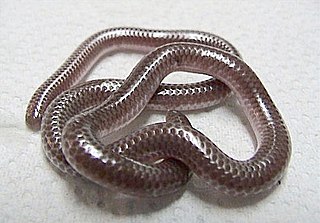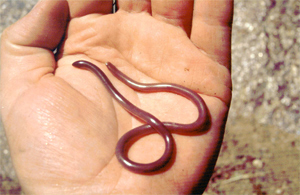
Amphisbaenia is a group of usually legless squamates, comprising over 180 extant species. Amphisbaenians are characterized by their long bodies, the reduction or loss of the limbs, and rudimentary eyes. As many species have a pink body and scales arranged in rings, they have a superficial resemblance to earthworms. While the genus Bipes retains forelimbs, all other genera are limbless. Although superficially similar to the snakes and blind lizards, recent phylogenetic studies suggest that they are most closely related to the true lizards. Amphisbaenians are widely distributed, occurring in North America, Europe, Africa, South America, Western Asia and the Caribbean. They are not found east of the Caspian Sea. Most species are less than 6 inches (150 mm) long.

George Albert Boulenger was a Belgian-British zoologist who described and gave scientific names to over 2,000 new animal species, chiefly fish, reptiles, and amphibians. Boulenger was also an active botanist during the last 30 years of his life, especially in the study of roses.

Rena dulcis, also known commonly as the Texas blind snake, the Texas slender blind snake, or the Texas threadsnake, is a species of snake in the family Leptotyphlopidae. The species is endemic to the Southwestern United States and adjacent northern Mexico. Three subspecies are currently recognized, including the nominate subspecies described here.
Lumbricalis may refer to:

Carphophis is a genus of small colubrid snakes endemic to the United States. The genus consists of two species.
Ramphotyphlops is a genus of nonvenomous blind snakes found in southern and southeast Asia, as well as many islands in the southern Pacific Ocean. They occur in a wide variety of habitats. Currently, 21 species are recognized.
Tricheilostoma is a genus of snakes in the family Leptotyphlopidae. All of the species were previously placed in the genus Leptotyphlops.

Xerotyphlops vermicularis, the European blind snake, European worm snake, Eurasian blind snake, or Eurasian worm snake, is a species of snake in the genus Xerotyphlops. Despite its common name, the range of the European blind snake ranges from the Balkan Peninsula, the Aegean Islands, and Cyprus to Afghanistan. The common name refers to how it is the only blindsnake of the genus Typhlops naturally found in Europe. The only other blindsnake found in Europe is the brahminy blindsnake, or "flowerpot snake," Ramphotyphlops braminus, where specimens have been discovered lurking in the soil at the Kew Gardens.
T. vermicularis may refer to:
The reticulate blind snake is a species of snake in the family Leptotyphlopidae. It is endemic to Somalia.
Leptotyphlopinae are a subfamily of snakes found in equatorial Africa.
Namibiana is a genus of snakes in the family Leptotyphlopidae. All of the species were previously placed in the genus Leptotyphlops.
Myriopholis is a genus of snakes in the family Leptotyphlopidae. Most of the species were previously placed in the genus Leptotyphlops.






